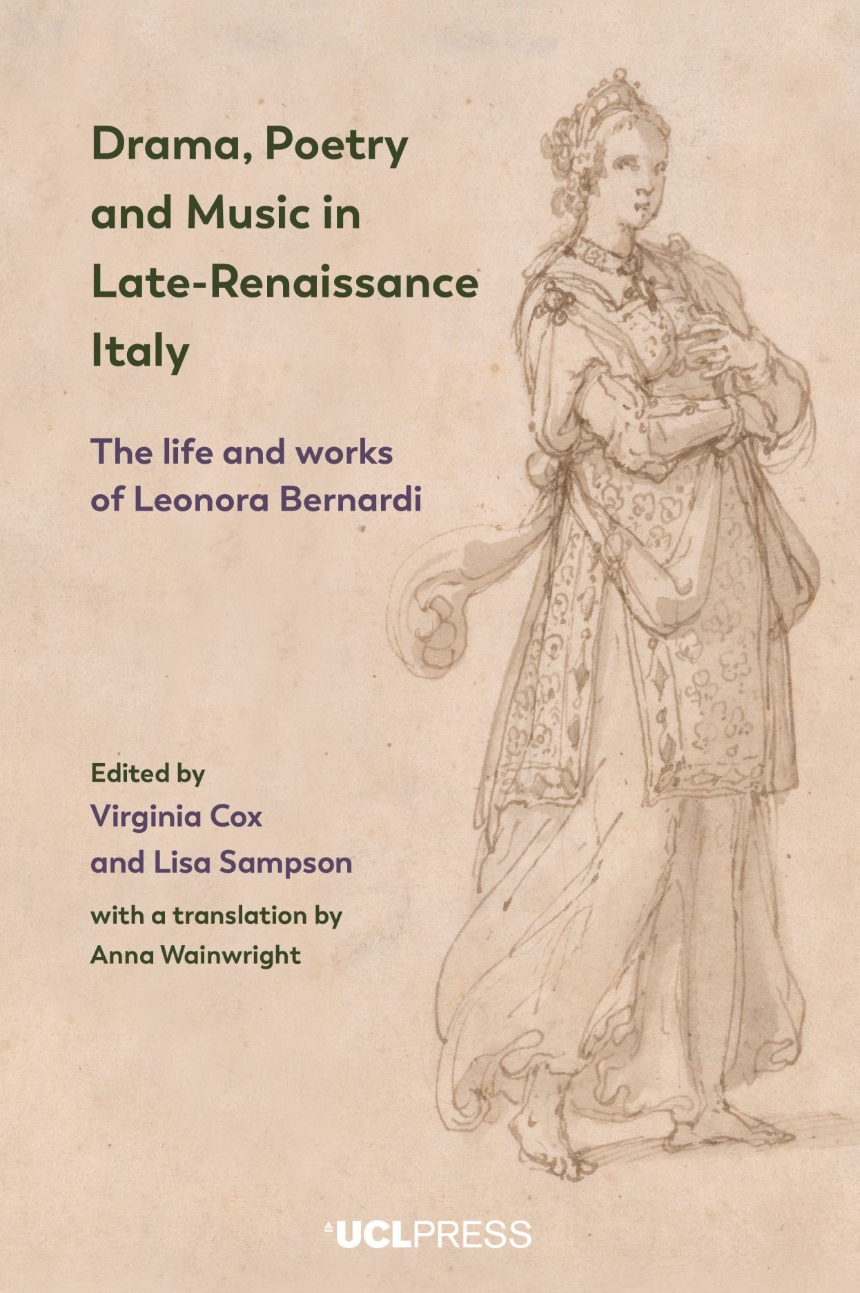9781800084315
9781800084322
Distributed for UCL Press
Drama, Poetry and Music in Late-Renaissance Italy
The Life and Works of Leonora Bernardi
The first-ever study of Leonora Bernardi’s life along with a modern edition of her recently discovered literary corpus.
Leonora Bernardi (1559–1616), a gentlewoman of Lucca, was a highly regarded poet, dramatist, and singer. She was active in the brilliant courts of Ferrara and Florence at a time when creative women enjoyed exceptional visibility in Italy. Like many such figures, she has since suffered historical neglect. Drama, Poetry and Music in Late-Renaissance Italy presents the first-ever study of Bernardi’s life along with a modern edition of her recently discovered literary corpus, which mostly exists in manuscripts. Her writings are presented in the original Italian with new English translations, scholarly notes, and critical essays. Based on new archival research, the substantial opening section reconstructs Bernardi’s unusually colorful life. The second major section presents her pastoral tragicomedy Clorilli, one of the earliest secular dramatic works by a woman. The third section presents Bernardi’s secular and religious verse, which engaged with new trends in lyric and poetry for music, and was set by various key composers across Italy. The volume thus firmly positions Leonora Bernardi as a distinctive voice and dynamic player in the extraordinarily rich social, cultural, and geo-political networks of late-Renaissance Italy.
Leonora Bernardi (1559–1616), a gentlewoman of Lucca, was a highly regarded poet, dramatist, and singer. She was active in the brilliant courts of Ferrara and Florence at a time when creative women enjoyed exceptional visibility in Italy. Like many such figures, she has since suffered historical neglect. Drama, Poetry and Music in Late-Renaissance Italy presents the first-ever study of Bernardi’s life along with a modern edition of her recently discovered literary corpus, which mostly exists in manuscripts. Her writings are presented in the original Italian with new English translations, scholarly notes, and critical essays. Based on new archival research, the substantial opening section reconstructs Bernardi’s unusually colorful life. The second major section presents her pastoral tragicomedy Clorilli, one of the earliest secular dramatic works by a woman. The third section presents Bernardi’s secular and religious verse, which engaged with new trends in lyric and poetry for music, and was set by various key composers across Italy. The volume thus firmly positions Leonora Bernardi as a distinctive voice and dynamic player in the extraordinarily rich social, cultural, and geo-political networks of late-Renaissance Italy.
552 pages | 15 color illustrations | 6.14 x 9.21 | © 2023
Culture Studies:
History: European History
Women's Studies:
Table of Contents
List of figures and tables List of contributors Abbreviations Acknowledgements 1 Context, life, legacy - Virginia Cox 1.1. Context 1.1.1. A troubled city: Lucca in the Cinquecento 1.1.2. Poetry, music, and spectacle in Lucca 1.1.3. Women’s participation in Lucchese cultural life 1.2. Life 1.2.1. 1559-1579. Girlhood and marriage (Lucca, Castelnuovo) 1.2.2. 1579-1584. Married life (Lucca, Florence, Ferrara) 1.2.3. 1585-1588. Widowhood, scandal, banishment (Ferrara, Lucca, Florence) 1.2.4. 1588. Poetic rehabilitation (Florence) 1.2.5. 1589-1598. Exile (Florence, Ferrara) 1.2.6. 1599-1603. The ridotto years (Lucca) 1.2.7. 1603-1616. Religious retreat (Lucca) 1.3. Legacy 1.4. Conclusion 1.5. Appendix: The scandal of 1588 in the chronicle of Lorenzo Trenta and in the open letter of Girolamo Sbarra 2 Clorilli and late-Renaissance theatre 2.1. Bernardi’s Clorilli and pastoral drama between Ferrara and Florence - Lisa Sampson 2.1.1. Pastoral drama: The Ferrarese tradition 2.1.2. Court and academies in Ferrara 2.1.3. Bernardi’s Clorilli: Structure and themes 2.1.4. Bernardi’s pastoral in Florence: Contexts of performance 2.1.5. Female pastoral in Florence: Drama, poetry and music 2.2. The Marciana manuscript of Clorilli - Lisa Sampson 2.2.1. Authorship, anonymity and agency 2.2.2. The production of the Marciana manuscript 2.2.3. The diverse rime 2.2.4. Reception and transmission of Clorilli (Florence, Lucca and Venice) 2.2.5. Appendix: Contents of the Marciana Codex, MS It. IX, 239 (=6999) 2.3. Clorilli Italian text edited by Lisa Sampson, translation by Anna Wainwright, and notes by Lisa Sampson and Anna Wainwright 2.3.1. Transcription criteria 2.3.2. Text 2.3.3. Translation and notes 2.3.4. Notes on translation 2.4. Green acts in green shades: adapting and staging Clorilli at Villa La Pietra, Florence, 2018 - Eric Nicholson 2.4.1. Green worlds 2.4.2. Water 2.4.3. Rejections, separations, and confrontations 2.4.4. Projections and reunions 2.4.5. Fusion, renewal, and community celebration 3 Bernardi’s lyric verse and its musical settings 3.1. Leonora Bernardi, lyric poet - Virginia Cox 3.1.1. Sources 3.1.2. The Marian Muse 3.1.3. In dialogue with Leonora Bernardi: Angelo Grillo 3.1.4. In dialogue with Leonora Bernardi: Ottavio Rinuccini 3.1.5. Songs of love 3.2. The musical settings of Bernardi’s verse - Eugenio Refini 3.2.1. Ferrarese echoes in madrigal settings of Bernardi’s poetry 3.2.2. Bernardi’s ‘tears’ across polyphony and monody 3.2.3. Sienese connections and textual variants: The nymph’s canzonetta 3.2.4. Transcriptions of the musical settings - Davide Daolmi and Eugenio Refini Bibliography Index

